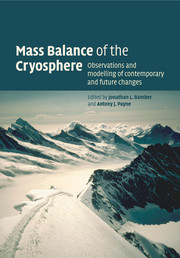Book contents
- Frontmatter
- Contents
- List of contributors
- Foreword
- Preface
- 1 Introduction and background
- Part I Observational techniques and methods
- Part II Modelling techniques and methods
- 5 Modelling land-ice surface mass balance
- 6 Modelling land-ice dynamics
- 7 Modelling the dynamic response of sea ice
- Part III The mass balance of sea ice
- Part IV The mass balance of the ice sheets
- Part V The mass balance of ice caps and glaciers
- Index
- References
5 - Modelling land-ice surface mass balance
Published online by Cambridge University Press: 16 October 2009
- Frontmatter
- Contents
- List of contributors
- Foreword
- Preface
- 1 Introduction and background
- Part I Observational techniques and methods
- Part II Modelling techniques and methods
- 5 Modelling land-ice surface mass balance
- 6 Modelling land-ice dynamics
- 7 Modelling the dynamic response of sea ice
- Part III The mass balance of sea ice
- Part IV The mass balance of the ice sheets
- Part V The mass balance of ice caps and glaciers
- Index
- References
Summary
Introduction
The topic of this chapter is the surface mass balance, often called the specific balance, specific mass balance (as in Chapter 2) or simply the mass balance. The surface mass balance is defined as the total change in mass in a vertical column of glacier material during an undefined amount of time (in this chapter, the term ‘glacier’ refers to small glaciers, ice caps and ice sheets). Glacier material may include snow, ice and water. Changes in mass due to divergence or convergence of the ice velocity field are excluded, as well as mass changes due to processes occurring at the bedrock. Positive contributions to the mass balance are called accumulation, and negative contributions are called ablation. Snow fall is the dominant process causing accumulation on glaciers. In the lower parts of glaciers, ice caps and the Greenland ice sheet, melt followed by runoff of the melt water is the dominant ablation process. Other processes that contribute to the mass balance are evaporation (change from liquid to gas), condensation (change from gas to liquid) and sublimation (change from gas to solid and vice versa), removal and deposition of snow by avalanches and wind, and rain water that does not run off. In Antarctica and the higher parts of the Greenland ice sheet, sublimation forms the dominant contribution to ablation. Mass balance is often expressed in kg/m2, but the most widely employed unit is mm water equivalent or m water equivalent.
- Type
- Chapter
- Information
- Mass Balance of the CryosphereObservations and Modelling of Contemporary and Future Changes, pp. 117 - 168Publisher: Cambridge University PressPrint publication year: 2004
References
- 20
- Cited by



